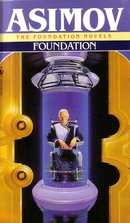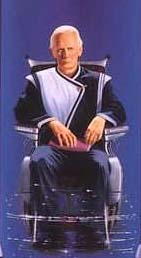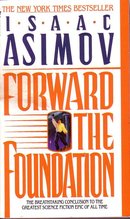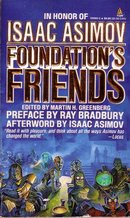The Foundation Series
|
|

The Foundation Series is an epic science fiction series written over a span of forty-nine years by Isaac Asimov. It consists of ten volumes (about one-million words), which, although they can be read separately, are closely linked to one another. The term 'Foundation Series' is often used more generally to include the Robot Series and Empire Series, which are set in the same fictional universe. They have a combined length of fourteen novels and dozens of short stories written by Asimov, and six novels written by other authors after his death.
The premise of the series is that mathematician Hari Seldon has spent his life developing a branch of mathematics known as psychohistory, a concept devised by Asimov and his editor John W. Campbell. It uses the law of mass action to predict the future on a large scale, such as of planets or empires. Using these techniques, Seldon foresees the fall of the Galactic Empire, which encompasses the entire Milky Way. He also predicts that there will be a thirty-thousand-year dark age before the next great empire rises. To prevent this, he decides to create a small haven of technology in a corner of the galaxy (on the planet Terminus) called the Foundation, whose job it will be to preserve knowledge after the collapse, thus reducing the time required for the next Empire to rebuild. If done properly, it will take only a thousand years before the next empire rises.
| Contents |
The trilogy

The series started as a series of nine short stories, eight of which were published in Astounding Science Fiction magazine (between May 1942 and January 1950) and a ninth, which was written a few years later when the series was first published in book form. The stories vary in length from about 7,000 words to about 50,000 words. The early stories are very closely based on Edward Gibbon's The History of the Decline and Fall of the Roman Empire (Asimov said he did "a little bit of cribbin' from the works of Edward Gibbon" when describing the influence of that work on the Trilogy).
These were then collected and published as Foundation, Foundation and Empire, and Second Foundation in the early 1950s by Gnome Press. These three books are thus known collectively as The Foundation Trilogy.
The sequels
Asimov unsuccessfully tried to end the series at the end of Second Foundation. But, because of the predicted thousand years until the rise of the next Empire (of which, only a few hundred had elapsed), the series lacked a sense of closure. For decades, fans pressured him to write a sequel.

In 1982, following a thirty-year hiatus, Asimov gave in and wrote what was at the time a fourth volume: Foundation's Edge. This was followed shortly thereafter by Foundation and Earth. Foundation and Earth (which takes place some 500 years after Seldon) ties up all the loose ends, but opens a brand new line of thought in the last dozen pages. As a result, many fans (wanting a tidy end to the series) consider this finale to be a failure. According to his widow Janet Asimov (in her biography of him, It's Been a Good Life), he had no idea how to continue after Foundation and Earth, so he started writing the prequels.
Merging with other series
The series is set in the same universe as Asimov's first published novel, Pebble in the Sky, although Foundation takes place approximately ten thousand years later. Pebble in the Sky became the basis for the Empire Series. Then, at some unknown date (prior to writing Foundation's Edge) Asimov decided to merge the Foundation series with his Robot series. Thus, all three series are set in the same universe, giving them a combined length of 15 novels and a total of about 1,500,000 words. The merge also created a time span of the series of approximately 20,000 years.
The prequels
The prequels, written last in the series but chronologically first, tell the life story of Hari Seldon and (simultaneously) the development of Psychohistory. The first prequel, Prelude to Foundation, starts with a young Hari Seldon presenting a paper outlining the possibility of psychohistory, and ends about a year later. The second novel, Forward the Foundation, takes place at intervals starting about ten years after Prelude to Foundation. It tells how psychohistory becomes functional, all while Hari loses loved ones and the Galactic Empire continues to break apart. Forward the Foundation ends just as Hari finishes recording the messages to be played throughout the original trilogy.

Other authors
Asimov's novels covered only 500 of the expected 1,000 years it would take for the Foundation to become a galactic empire. After his death, the Asimov estate at the request of Janet Asimov approached Gregory Benford and asked him to write another Foundation story. He agreed, and at that same time suggested that it should form part of a trilogy with Greg Bear and David Brin writing the other two books, which they agreed to do. All three take place between Asimov's two prequels. These three books are now known collectively as the Second Foundation Trilogy. Many fans, eager for the second trilogy to fill in the gap, were disappointed.
Also, shortly before his death in 1992, Asimov approved an outline for three novels, known as the Caliban Trilogy by Roger MacBride Allen, set between Robots and Empire and the Empire Series. The Caliban Trilogy describes the terraforming of the Spacer world Inferno, a planet where an ecological crisis forces the Spacers to abandon many long-cherished parts of their culture. Allen's novels echo the uncertainties which Asimov's later books express about the Three Laws of Robotics, and in particular the way that a thoroughly roboticized culture can degrade human initiative.
The Foundation universe was once again revisited in Foundation's Friends (ISBN 0312931743 hardback, ISBN 0812509803 paperback), a collection of short stories written by many prominent science fiction authors of today. Orson Scott Card's "The Originist" clarifies the founding of the Second Foundation shortly after Seldon's death; Harry Turtledove's "Trantor Falls" tells of the efforts by the Second Foundation to survive during the sacking of Trantor; and George Zebrowski's "Foundation's Conscience" is about the efforts of a historian to document Seldon's work following the rise of the second Galactic empire.

There are novels by various authors (Asimov's Robot City series, Isaac Asimov's Robots and Aliens series, and Isaac Asimov's Robots in Time series) loosely connected to the Robot Series, but they contain many inconsistencies with Asimov's books, and are not generally considered part of the Foundation Series.
Cultural impact
An eight-part radio adaptation of the original trilogy, with sound design by the BBC Radiophonic Workshop, was broadcast on BBC Radio 3 in 1973 - one of the first BBC radio drama serials to be made in stereo. A BBC 7 rerun commenced in July 2003.
In 1965, the Foundation Trilogy beat several other science fiction and fantasy series (including The Lord of the Rings by J. R. R. Tolkien) to receive a special Hugo Award for "Best All-Time Series". It is still the only series so honored. Asimov himself wrote that he assumed the one-time award had been created in order to honor The Lord of the Rings and he was amazed when his work won.
George Lucas used elements of the Foundation series to construct the universe in which Star Wars is set, including propulsion by hyperdrive and the Galactic Empire (although Lucas' Empire was by definition evil, while Seldon openly says that in principle the First Empire is not evil). Additionally, Coruscant, the imperial capital planet covered completely with buildings, is a direct borrowing of Asimov's Trantor. (Visually they are not exactly similar: Trantor is covered in domed cities, while Coruscant's buildings are open to the air. Trantor's domed structure is a little more practically designed, in terms of exposure to inclement weather.)
In 1995, Donald Kingsbury wrote "Historical Crisis", which he later expanded into a novel, Psychohistorical Crisis (ISBN 0312861028). It is not set in the same fictional universe as the Foundation series, but the universe described in it is very much similar to that of the Foundation series, being a clear and conscious borrowing. The novel explores the ideas of psychohistory into a number of new directions, inspired by more recent developments in mathematics and computer science, as well as by new ideas in science fiction itself.
The oboe-like "holophonor" in Matt Groening's animated television series Futurama is based directly upon the "Visi-Sonor" which Magnifico plays in Foundation and Empire. (See the DVD commentary for the series' final episode, "The Devil's Hands are Idle Playthings".)
It has been speculated—most prominently in the science fiction 'zines Ansible (No. 172, November 2001) and Locus—that the Foundation trilogy, which has had considerable success in the Middle East, was the source of the name of the terrorist group Al-Qaida. This speculation, however, fails to account for the fact that the term Al-Qaida, Arabic for "The Foundation", was first used by the United States to describe followers of Osama bin Laden and is not used by that group to refer to itself.
Also, the highly controversial Aum Shinrikyo sect in Japan (which attacked the Tokyo subway with Sarin gas) was trying to build a community of scientists after the model of the Foundation and used this book as its inspiration.
List of books
Prelude to Foundation contains Asimov's suggested reading order/chronology for his science fiction books in the introduction. The recommended reading order of the books is below. However, it is possible that reading the books in a different order than they were written will change the understanding of the series, because it could ignore the evolution of Asimov's thinking about the Foundation or spoil plot surprises.
Robot short stories
- I, Robot (1950), the first collection of Asimov's robot stories, which were all included in The Complete Robot, though it also contains interesting binding text (Mind and Iron), no longer in The Complete Robot.
- The Complete Robot (1982), Collection of Asimov stories written between 1940 and 1976.
- Robot Dreams (1986), Anthologized in a book with the same title.
- Robot Visions (1990), Anthologized in a book with the same title.
- The Positronic Man (1992), A novel based on Asimov's short story The Bicentennial Man, co-written by Robert Silverberg
The Robot novels
The Caliban trilogy
- Isaac Asimov's Caliban (1993) by Roger MacBride Allen
- Isaac Asimov's Inferno (1994) by Roger MacBride Allen
- Isaac Asimov's Utopia (1996) by Roger MacBride Allen
The Empire series
The Foundation novels
The Second Foundation Trilogy
- Foundation's Fear (1997) by Gregory Benford
- Foundation and Chaos (1998) by Greg Bear
- Foundation's Triumph (1999) by David Brin
The Foundation Trilogy
Note that this list corrects several mistakes found in the list in Asimov's Prelude to Foundation. It also adds six novels that were published after Asimov's death in 1992.
Books not included
While not mentioned in the above list, the books The End of Eternity (1955) and Nemesis (1989) are considered part of the series by some.
The End of Eternity is vaguely referenced in Foundation's Edge, where a character mentions the Eternals, whose "task it was to choose a reality that would be most suitable to Humanity". (The End of Eternity also refers to a "Foundation" within its story.) In Forward the Foundation Hari Seldon refers to a twenty thousand year old story of "a young woman that could communicate with an entire planet that circled a sun named Nemesis," an obvious reference to Nemesis.
On the other hand, these references might be just jokes by Asimov, and the stories mentioned could be just those really written by himself. Furthermore, Asimov himself did not mention The End of Eternity in the series listing from Prelude to Foundation. As for Nemesis, it was written after Prelude to Foundation, but in the author's note Asimov explicitly states that the book is not part of the Foundation series, but that some day he might tie it to the others.
Major characters
- Hari Seldon, the founder of the Foundation
- R. Daneel Olivaw
- The Mule
- Dors Venabili, Seldon's wife
- Emperor Cleon I
- Salvor Hardin
- Bel Riose
- Golan Trevize
- Janov Pelorat
See also
External links
- books.guardian.co.uk: Terrorism and the Foundation series (http://books.guardian.co.uk/review/story/0,12084,779530,00.html)
- Isaac Asimov's Foundation Series website including UK Voyager cover artwork (http://www.vavatch.co.uk/books/asimov/)
- Worlds mentioned in the Foundation series (http://www.asimovonline.com/oldsite/trantorian_empire.html) from AsimovOnline
- The 'Galactic Encyclopedia' - comprehensive listing of characters from Robot/Foundation series (http://www.geocities.com/Area51/Dimension/1136/pages/eghome.html)
- The Foundation Trilogy: Notes, Articles, and Links (http://www.pannis.com/SFDG/TheFoundationTrilogy/index.html)
- The 'Foundation Game' - Game based on the Foundation series (http://www.foundationgame.com/)
| Preceded by: | Series: |
|---|---|
| Empire Series | Foundation Universe |
fr:Cycle de Fondation it:Ciclo della Fondazione he:סדרת המוסד th:สถาบันสถาปนา (ชุดหนังสือ)
